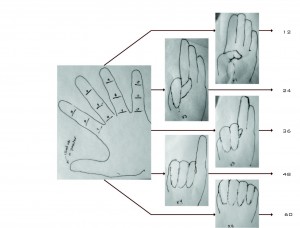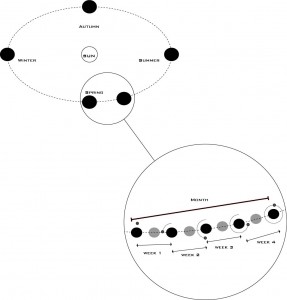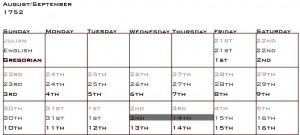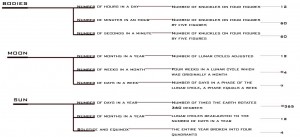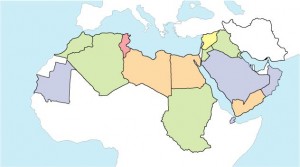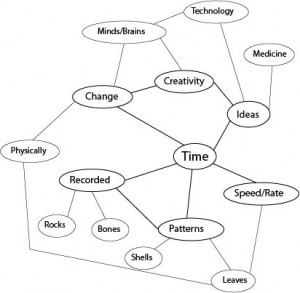Gnomon
Gnomon, a Greek word meaning “indicator”
The gnomon was the first form of a time device. The first one was either built in Mesopotamia China, or Egypt. It is not known how it was originally made but it was probably from a stick being stuck in the ground, or inspired by the observation of a human’s shadow.
The Gnomon was not very accurate. If it was too short the change in the shadow through the day was too slight, but if it was too tall the shadow would be out of focus.
The main objective of the gnomon was to show the Zenith or “noon”. By finding the exact location of noon, north could be obtained during the day, when the north star is not visible.
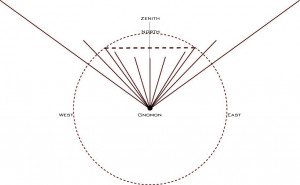
The Sundial
Sundials were then created, also known as shadow clocks and a great deal more accurate than the original gnomon.
“In this case the shadow would always take the same direction for the same hour at an given place regardless of the day of the year, only [the shadow’s] would change” (p.13, LeLionnais)
They were first made in Egypt and later improved upon in Greece by Aristarchus or Eratosthenas of Cyrene at the end of the 3rd century BC to be used to calculate latitudes. They did this by placing the gnomon onto a hemispherical dial.
Through the years that the sundial was being perfected thirteen different models were created according to Vitruvious. These models varied based on orientation and curvature of the dial as well as the size, whether it be portable or monumental
For the Overcast Days
CLEPSYDRA
The Clepsydra was either invented by the Chaldeans, who showed it to the Phoenicians who brought it to the Egyptians, or the Egyptians invented it separately. Either way the name comes from greek meaning “Water Thief”. A Clepsydra is water clock that operates by having a vessel with lines marked on it where the water level would be at that time. These are relatively accurate except water pressure was not accurately accounted for. so they are consistent for an given location but if the altitude changes or the volume of water varies the speed at which the water fills the vessel can vary.
There are two forms of these clocks. One where the time was marked on the vessel it was leaving or the other where it was marked on the one it was entering. The latter, shown above works as a series where when the bottom container fills the original container, now empty can plug its hole and be used to collect the water of the second. The earliest writing about the clepsydra suggests it was used as early as 1580 BC in Egypt and the oldest one found is from 1400 BC built by Amenophis III.
There are records of China using the Clepsydra in 1000 BC and the Greeks used it in 325 BC.
USES OF THE CLEPSYDRA
The Greeks extended it use and value to astronomy allowing them to measure the diameter of the sun and moon by the time it took for one to pass across a line from edge to edge.
It was used by Herophilus of Alexandria to measure people’s pulses.
One was set up at the central clock of the agora in Athens.
It was used in court houses, lawyers would be granted a one clepsydra to finish their argument
Plato made his into an alarm clock with 12 doors and marble’s that would “strike” the hour
Galileo developed a mercury version to measure his experiments. Through this he was able to develop the law of free falling bodies. The distance a body covers in falling is proportional to the square of the time it takes to complete the fall.
WAX CLOCKS
Near the end of the 9th century Alfred the Great of England would keep track of time by burning a candle. These candles were wind controlled as to not effect the speed at which the candle would burn. The candles he used were about four hours, though this number is very rough.
Monks took the next step in developing wax clocks by making a candle that burned for an hour almost exactly surrounded by a wooden box to help control the wind around it.
This was developed into the “light-clock”, developed by al-jazari in 1206 AD. This advance consisted of a candle that lasted 13 hours. In the candle there were 13 marbles that were equally spaced so that after burning the candle for an hour a marble would released form the wax.
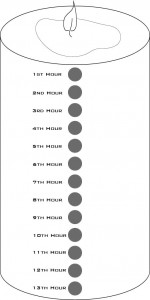
MORE LIQUID CLOCKS
The native Americans found that they could measure the length of time by putting a hole at the bottom of a boat and allowing it to sink.
A sophisticated version of this was introduced by the early Saxons who would use bronze vessels that were standard, but varied in volume and size of the holes in the vessels could vary from under an inch to over 10 inches.
This form of time keeping is still used for irrigation in Algeria and Upper Egypt.
SAND GLASSES
Better known as an hourglass is a later form of a time tracking device but was not an adaptation of the Clepsydra.
They were first introduced in the 14th century. Their main uses were by clergy to regulate masses and by sailors to mediate the speed of the ship. The only commons uses were as timers in kitchens and at chess matches. The sand glass was not nearly as influential as most other well known time devices, but
“of all the devices ever invented to measure time, the sandglass seems best able to symbolize our own feelings”
(p.26, LeLionnais)


